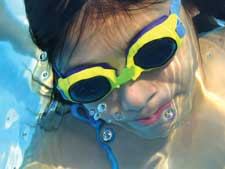STATIC APNEA
While not common in the United States, it is important to acknowledge an “extreme sport” generally known as static apnea. Static apnea is a competitive sport particularly popular in Europe with enthusiasts who attempt to increase time underwater in a static or motionless position. The sport is practiced in pools, usually sitting on the bottom and including the use of weights.
Two world associations, AIDA and CMAS, govern the sport as well as other competitive freediving sports such as underwater distance swimming with and without fins. Astonishing times have been achieved in the sport. The 2007 static apnea world record for women is 8 minutes and for men, 9 minutes, 8 seconds. Typically, aquatics professionals encounter the sport when an enthusiast is visiting and wants to continue training. The recently well-publicized television stunt of David Blaine’s, “Drowned Alive,” could further popularize “breath-holding sport” and bring more enthusiasts wishing to “practice” in aquatics facilities.
It is important for facility managers to recognize the implications of allowing such training in their pools. Consider the fact that we train lifeguards to regard anyone who is submerged or face down and motionless for 30 seconds as a passive drowning victim, and we require them to check on the victim’s condition immediately.
It is difficult, if not impossible, for our guards to know when a static apneist is in trouble because he/she will be underwater for much longer than 30 seconds. Certainly, this should never be allowed during a recreational swim period because the lifeguard attention required to supervise this activity would dangerously decrease attention needed for other persons in the pool.
Hyperventilation, breath-holding, shallow-water blackout and hypoxic training are terms that can be confusing, especially when trying to determine which safety policies to follow. In addition, lifeguards need accurate information regarding these topics to prevent dangerous activities and respond to emergencies.
Hyperventilation can be defined as an excessive rate and depth of respiration leading to abnormal loss of carbon dioxide (CO2) from the blood. Swimmers can purposely induce this condition by executing a series of deep breaths followed by forced exhalation prior to breath-holding. This is done in an attempt to remain underwater for a longer period of time.
This technique works because it decreases CO2 levels in the blood. CO2 is responsible for triggering the need to breathe. With less CO2, a swimmer will not feel the need to take a breath as quickly and can remain underwater longer. However, this doesn’t mean the swimmer won’t need oxygen. Oxygen levels are being depleted.
In fact, oxygen levels can be depleted more quickly if the swimmer is moving or swimming rather than remaining stationary. If oxygen levels in the blood drop sufficiently before CO2 levels trigger the need to breathe, the swimmer will become unconscious. This is also commonly referred to as shallow-water blackout. Obviously, unconscious swimmers will breathe water into their lungs and die if not rescued and resuscitated.
For this reason, a number of agencies have standards or policies prohibiting hyperventilation or breath-holding. The American Red Cross refers to hyperventilation in its Swimming and Water Safety text as “potentially dangerous” and “risky,” and in its Safety Training for Swim Coaches as “a dangerous practice that may result in drowning.” The American Red Cross’ Lifeguarding text also refers to how hyperventilation can result in a passive drowning victim and that patrons should be directed not to engage in prolonged breath-holding (greater than 30 seconds).
The Medical Advisory Committee of the YMCA of the USA states that Y’s should prohibit extended underwater breath-holding. The U.S. Navy’s Department of Morale, Welfare and Recreation policy states, “This practice of hyperventilating and extended breath holding is prohibited at MWR aquatics facilities. Signs will be posted prohibiting breath-holding and hyperventilation.”
While recognizing the need to train certain military personnel by engaging in high-risk aquatic activities such as extended breath-holding (anoxia training), the Canadian Forces Personnel Support Agency also states “… they must do so under the direct supervision of a ‘buddy’ (the buddy may not be an on-duty lifeguard). In addition, anyone wishing to do anoxia training must inform the lifeguard prior to commencing the session.”
Hypoxic training is sometimes confused with hyperventilation. The development of hypoxic training is credited to legendary swimming coach Dr. James Counsilman of Indiana University. Hypoxic training is “low oxygen” training and involves the reduction or elimination of breathing while training. In swimming, this typically involves breathing every five, seven or nine strokes, or limited underwater swimming. It was originally thought that reducing levels of oxygen would result in physiological adaptations similar to high-altitude training.
It’s also believed that reducing the number of breaths would increase the swimmer’s speed because breathing tends to increase drag. Subsequent research has proven that sea-level hypoxic training does not produce any physiological adaptations. Hypoxic training, however, remains popular because it familiarizes swimmers with the discomfort and stress of low oxygen and can discipline swimmers to keep strong techniques during the stress of a race.
Some swimmers and coaches have taken hypoxic training to the extreme, combining it with hyperventilation with tragic results. The scenario is almost always either “lung buster 25 repeats” or underwater swims to maximum distances. For this reason, the CFPSA has defined hypoxic training by limiting it to “exercise at levels of reduced oxygen” rather than no oxygen from extended breath-holding.
USA Swimming recommends that “hypoxic training should be carried out only under close supervision.” The American Red Cross states, “Hypoxic training (breathing on a restricted schedule) may be used safely in a training program of experienced swimmers in good physical condition, with proper supervision and instruction. The number of repeats of practice sets of hypoxic training should be limited. Adequate time for recovery will vary from swimmer to swimmer. Hypoxic training should be limited to older and more experienced swimmers. To prevent hyperventilation, have swimmers take only one or, at the most, two deep breaths before beginning hypoxic training.”
Lung capacity diminishes with age, so Kevin Milak, technical editor at Swimming Technique magazine recommends that “Masters swimmers using hypoxic training should be watched very carefully.” Though there are differing opinions regarding the value of hypoxic training, there is large support for doing so only under close supervision.
It’s clear that hyperventilation and prolonged breath-holding are dangerous, and aquatics professionals need to develop prevention and education strategies.
Tom Griffiths, director of aquatics and safety officer for athletics at Pennsylvania State University, advocates the prevention of competitive and repetitive breath-holding. All pools at Penn State post signs stating, “No Prolonged Underwater Swimming Or Breath Holding” and “Competitive and Repetitive Breath Holding Can Be Deadly.”
Part of the problem is that lifeguards tend to not focus on highly skilled swimmers, which could mean a missed rescue. Guards need education and training to prepare for this scenario. The American Red Cross and the YMCA provide this information in their lifeguard training texts, and the Red Cross has an in-service training outline that includes prolonged breath-holding information in its “Lifeguard Management” CD-ROM.
Despite the fact that these agencies have included information in their training manuals, most facilities do not have policies addressing this issue. Griffiths conducted a six-month survey of just under 300 aquatics professionals and found a significant number did not have rules or signs banning prolonged underwater swimming and breath-holding. Of those, 11 percent experienced “breath-holding” rescues requiring resuscitations, with one-third being fatal.
Aquatics facility managers should consider having policies and/or signs to mitigate the risks of hyperventilation and prolonged breath-holding. The city of Los Angeles’ City Wide Aquatics does have such a policy. Aquatics directors provide education and training for lifeguards and managers so they are familiar with the policy and can prevent this practice.
Managers of aquatics facilities also should consider the types of programs they offer when training lifeguards about prolonged breath-holding. Programs such as synchronized swimming, underwater hockey and snorkeling (stand-alone or incorporated as part of a scuba program) may require additional information for guards to use to assess participants in these activities and to recognize when someone needs assistance or rescue.
In developing a policy, be sure to define terms such as hypoxic training when prohibiting or restricting activity such as the CFPSA did in its Aquatic & Water Safety Policy. In my opinion, deliberate hyperventilation should always be prohibited. Hypoxic training should be closely monitored to prevent accidental hyperventilation. Strategies to minimize or eliminate the risks of hyperventilation, prolonged or extended breath-holding and hypoxic training are:
- Signs prohibiting or restricting the activity
- In-service training and education for lifeguards and coaches, which rules should be enforced, what to look for, how to react and emergency action plans
- Policies that prohibit or restrict the activity
- Policies that minimize the risk by requiring any one or more of the following: supervision, buddy system, notification of lifeguard, permission of management, permission of parents, signing waivers.
Aquatics professionals may choose any of these strategies to address their particular needs. Assessment of aquatic programming, lifeguard training, audiences and resources must take place to determine which strategies will most effectively address the dangers associated with hyperventilation, prolonged breath-holding and hypoxic training at a particular facility.



